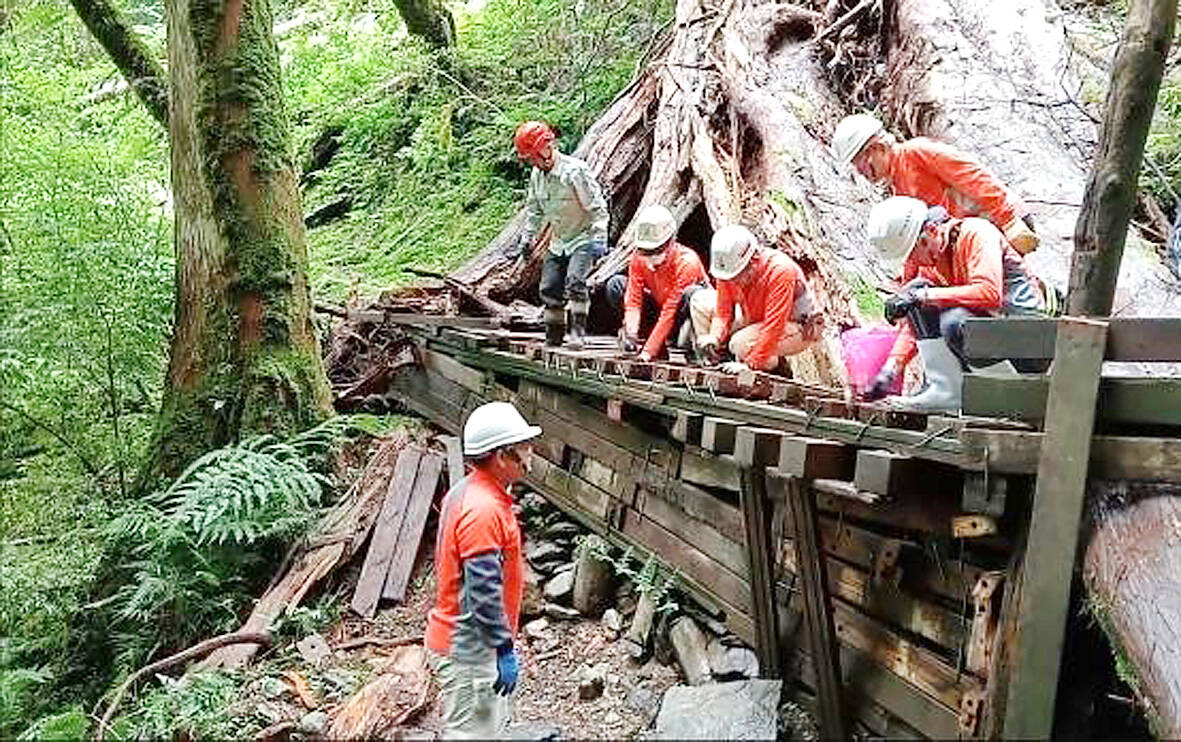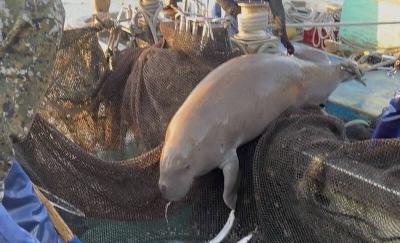People hiking through Taoyuan’s new Lalashan (拉拉山) National Forest Recreation Area might not realize they are walking on rock and wood taken from the surrounding area by volunteers who restored the trail using traditional methods.
The recreation area opened in April, beckoning hikers with its forest footpaths, including one known as the “handmade trail,” which snakes past the mountain’s “giant tree area” home to Taiwan cypress and Taiwan red cypress trees.
The trail, at an altitude of 2,200m, took eight years to complete by a group of volunteers, working under the guidance of the Forestry Bureau’s Hsinchu Forest District Office.

Photo courtesy of the Hsinchu Forest District Office.
The group was initially formed in 2013 and currently has 62 members whose ages range from their 20s to their 70s. They hail from across Taiwan and are joined by their shared love of hiking. Group members come from diverse backgrounds, including retired military officers, professors, high-tech executives, taxi drivers and farm owners.
Former team leader Lin Kuo-wen (林國文) said the members meet once a month, from Saturday to Monday, to work, survey and assess trail conditions, prepare tools and construction materials, lay down foundations and conduct maintenance on the trail.
The team has worked in several other national forest recreation areas, including Neidong (內洞) in New Taipei City’s Wulai District (烏來), as well as Manyueyuan (滿月圓), Dongyanshan (東眼山) and Guanwu (觀霧) in Hsinchu and Miaoli counties, he said.
The Lalashan area originally had trails covered with wooden boards, but the rainy and damp conditions in the mountain degraded the boards, which are not easy to maintain, Lin said.
The team began the renewal work on the footpath in 2015 to gradually turn it into what has become the “handmade trail,” he said, adding that the group ran into many issues.
“Oftentimes, we had already placed the rock foundation and the wooden boards in place, but had to remove and set them again, and other times, several group members had to work together a heavy boulder blocking the trail,” he said.
Many of the group’s members also slipped and fell on the narrow trail, sustaining injuries from thorny bushes, he added.
Hu Chiao-yun (胡僑芸), the team’s photographer, said the most challenging work came in early December 2020, with several days of heavy rain causing giant tree No. 23 to fall on a circular path.
Meanwhile, debris acculumated on a stream cut off access to giant tree Nos. 16 to 18 and damaged the path leading to giant tree No. 4, she said.
“Soon after, the COVID-19 pandemic began and we had to suspend out work to prevent infection. We resumed work in April last year, when the pandemic eased, but we had to rearrange the work units,” she added.
“When we launched new on-site surveillance, we found overgrown grass and brush, and some of the rock slabs and wooden boards we had placed were in disarray,” Hu said.
“When we saw the trail in that condition, we almost fainted right there,” she added.
“It took us four days to chisel the rocks and reset the slabs and wooden boards one by one. We also placed crushed stones to reinforce up the underlying foundation,” Hu said.
“Only then could we reconstruct the bridge for the trail to giant tree No. 23. Then we finished the climbing steps that lead to a viewing platform for giant tree No. 24,” she said.
Lin said the volunteer work had “no individual heroes. The results all came from teamwork.”
“We worked in mountainous forests at altitudes of 1,400m to 1,900m, often surrounded by fog. At times, it got really cold and we shivered in the wind, and other times the sun burned our skin,” he said.
However, “seeing the successful outcome gives us satisfaction, which overcomes physical fatigue,” he said.

‘DENIAL DEFENSE’: The US would increase its military presence with uncrewed ships, and submarines, while boosting defense in the Indo-Pacific, a Pete Hegseth memo said The US is reorienting its military strategy to focus primarily on deterring a potential Chinese invasion of Taiwan, a memo signed by US Secretary of Defense Pete Hegseth showed. The memo also called on Taiwan to increase its defense spending. The document, known as the “Interim National Defense Strategic Guidance,” was distributed this month and detailed the national defense plans of US President Donald Trump’s administration, an article in the Washington Post said on Saturday. It outlines how the US can prepare for a potential war with China and defend itself from threats in the “near abroad,” including Greenland and the Panama

A wild live dugong was found in Taiwan for the first time in 88 years, after it was accidentally caught by a fisher’s net on Tuesday in Yilan County’s Fenniaolin (粉鳥林). This is the first sighting of the species in Taiwan since 1937, having already been considered “extinct” in the country and considered as “vulnerable” by the International Union for Conservation of Nature. A fisher surnamed Chen (陳) went to Fenniaolin to collect the fish in his netting, but instead caught a 3m long, 500kg dugong. The fisher released the animal back into the wild, not realizing it was an endangered species at

The High Prosecutors’ Office yesterday withdrew an appeal against the acquittal of a former bank manager 22 years after his death, marking Taiwan’s first instance of prosecutors rendering posthumous justice to a wrongfully convicted defendant. Chu Ching-en (諸慶恩) — formerly a manager at the Taipei branch of BNP Paribas — was in 1999 accused by Weng Mao-chung (翁茂鍾), then-president of Chia Her Industrial Co, of forging a request for a fixed deposit of US$10 million by I-Hwa Industrial Co, a subsidiary of Chia Her, which was used as collateral. Chu was ruled not guilty in the first trial, but was found guilty

The Chinese Nationalist Party (KMT) is maintaining close ties with Beijing, the Democratic Progressive Party (DPP) said yesterday, hours after a new round of Chinese military drills in the Taiwan Strait began. Political parties in a democracy have a responsibility to be loyal to the nation and defend its sovereignty, DPP spokesman Justin Wu (吳崢) told a news conference in Taipei. His comments came hours after Beijing announced via Chinese state media that the Chinese People’s Liberation Army’s Eastern Theater Command was holding large-scale drills simulating a multi-pronged attack on Taiwan. Contrary to the KMT’s claims that it is staunchly anti-communist, KMT Deputy